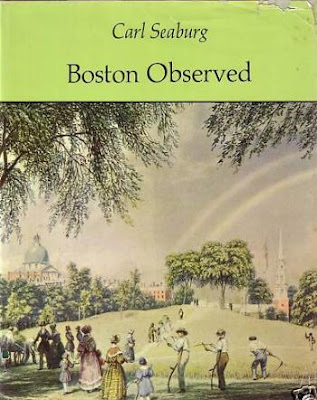
Beacon Hill reservoir - view from the State House, looking down the back of Beacon Hill towards the West End.
Once upon a time (as they say), Boston's drinking water supply was provided by individual wells. Indeed, the first Puritan settlers came to the Shawmut peninsula from Charlestown, where they suffered from the lack of easy access to water. The future Boston, on the other hand, had free flowing springs and well water easily accessible through light soil.
As the town grew, the need for water outstripped the availability. After an examination of the ponds of local communities, Jamaica Pond in the town of Roxbury was chosen, and in 1796, the Jamaica Plain Aqueduct Company was formed, and pipes of wooden logs were lain from the pond, along the Muddy river and across today's Mission Hill neighborhood to Boston. Jamaica Pond could not supply the entire town (later city) with drinking and fire-fighting water, however, and within a few decades Boston was looking for another, larger source of water.

Beacon Hill reservoir - 1883. Shown behind the original pre-addition State House building.
East Boston reservoir (BPL Flickr photo group).

East Boston reservoir, 1884.

South Boston reservoir, 1884.
With a growing population and a growing need for water, Boston looked west, and secured a new supply from a newly constructed Cochituate water system in 1848. Three distributing reservoirs were built within the city. There were at Beacon Hill, South Boston and East Boston. The Beacon Hill reservoir was built where the monument once stood, although due to leveling of the hill for fill, the foundation was seventy feet lower than the original peak. The reservoir held over 2.6 million gallons of water at just over 100 feet above tide marsh level. The South Boston reservoir, on Telegraph Hill, held 7.5 million gallons, and the East Boston reservoir, on Eagle Hill, had a capacity of 5.6 million gallons. Beacon Hill reservoir was torn down to make way for the expansion of the State House. The South Boston reservoir was torn down and replaced by South Boston High School by 1899. In East Boston, by 1922 the reservoir had been replaced by a playground. In 1926, the new East Boston High School was built on the site.

Roxbury standpipe - Fort Hill (BPL Flickr group).
In 1868, Roxbury was annexed to Boston, followed by Brighton, the short-lived town of West Roxbury and Dorchester. With a need to supply land sitting at higher elevations than much of Boston proper, the Cochituate Standpipe would be added to the system at Fort Hill in Roxbury. An interior water tank was surrounded by a spiral staircase and an outer brick tower wall. In later years, some would confuse the tower structure and the name of the location (Fort Hill), and assume that the post-Civil War water storage structure was the remains of a Revolutionary War fort. In fact, the hill was fortified during the occupation of Boston by the British - the hill guarded the road from Boston to Dedham, where the revolutionary forces kept arms and ammunition - but it was an earthworks fort.

Parker Hill reservoir, Roxbury, 1899.
The map above shows the Parker Hill reservoir. The Mission hill neighborhood and downtown Boston are to the top of the map, and Hyde square and Jamaica plain to the bottom. The connection goes down the hill to Heath street. The Parker Hill reservoir was built in 1873-74, with a capacity of 7.2 million gallons. Being at a much higher elevation than Fort Hill, the Parker Hill reservoir eventually replaced the nearby standpipe. In time, the pumping station at Chestnut Hill - which itself replaced a pumping station at Roxbury Crossing - would replace the need for elevated reservoirs in the city itself, thus clearing the way for the reuse of the lands by the city described above.

Finally, just for the sake of completeness, I'll add the original water tower on Bellevue Hill in West Roxbury. Bellvue Hill is the highest point in the city, and as old farmland was divided and developed, the new population needed a reliable water supply. This structure has since been replaced by a larger metal tank on the same site. Now surrounded by trees and hidden away, we can see from the postcard above that the site once allowed a great viewing site of the city.
Now - here's a little Easter Egg in this otherwise prosaic article on Boston's Victorian era waterworks for those who have stayed with me this far. During the 1960s, a commune formed around musician/cult leader Mel Lyman on Fort Hill. Combine 60s music with LSD and a Messianic loop-de-loo and you've got quite a story for our non-smoking, button-down times. Just punch Lyman's name into a search engine and you'll get the story, in its various insider/outsider versions. Lyman's 'family' are very much of the Sixties - a small, exceptional group, but one that does tell much of the time. While San Francisco far outdid Boston for both music and LSD, our fair city did have its very own nutter-guru.
 This is a late addition to this entry (1/30/12). From the Boston Globe, August 16, 1941.
This is a late addition to this entry (1/30/12). From the Boston Globe, August 16, 1941. Industrial School for Crippled and Deformed Children, 1928.
Industrial School for Crippled and Deformed Children, 1928.

















